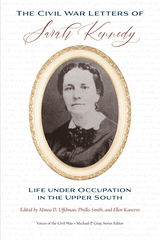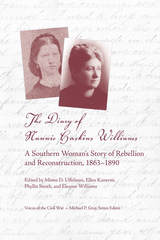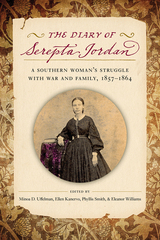3 have author last names that start with U have author last names that start with U

At the outbreak of the Civil War, Sarah Kennedy watched as her husband, D.N., left for Mississippi, leaving her alone to care for their six children and control their slaves in a large home in downtown Clarksville, Tennessee. D. N. Kennedy left to aid the Confederate Treasury Department. He had steadfastly supported secession and helped recruit local boys for the Confederate army. The Civil War Letters of Sarah Kennedy: Life under Occupation in the Upper South showcases the letters Sarah wrote to her husband during their time apart, offering readers an inside look at life on the home front during the Civil War through the eyes of a slave-owning, town-dwelling wife and mother.
Featuring fifty-two of Sarah Kennedy’s letters to her husband from August 16, 1862, to February 20, 1865, this important collection chronicles Sarah Kennedy’s personal struggles during the Civil War years, from periods of illness to lack of consistent contact with her husband and everything in between. Her love and devotion to her family is apparent in each letter, contrasting deeply with her resentment and harsh treatment toward her enslaved people as Emancipation swept through Clarksville. A useful volume to Civil War historians and women’s history scholars alike, The Civil War Letters of Sarah Kennedy pulls back the curtain on upper-middle-class family life and social relations in a mid-sized Middle Tennessee town during the Civil War and reveals the slow demise of slavery during the Union occupation.

and family as Nannie, began a diary. The Diary of Nannie Haskins Williams: A Southern
Woman’s Story of Rebellion and Reconstruction, 1863–1890 provides valuable insights into
the conditions in occupied Middle Tennessee. A young, elite Confederate sympathizer,
Nannie was on the cusp of adulthood with the expectation of becoming a mistress in
a slaveholding society. The war ended this prospect, and her life was forever changed.
Though this is the first time the diaries have been published in full, they are well known
among Civil War scholars, and a voice-over from the wartime diary was used repeatedly
in Ken Burns’s famous PBS program The Civil War.
Sixteen-year-old Nannie had to come to terms with Union occupation very early in
the war. Amid school assignments, young friendship, social events, worries about her
marital prospects, and tension with her mother, Nannie’s entries also mixed information
about battles, neighbors wounded in combat, U.S. Colored troops, and lawlessness in the
surrounding countryside. Providing rare detail about daily life in an occupied city, Nannie’s
diary poignantly recounts how she and those around her continued to fight long after
the war was over—not in battles, but to maintain their lives in a war-torn community.
Though numerous women’s Civil War diaries exist, Nannie’s is unique in that she also
recounts her postwar life and the unexpected financial struggles she and her family experienced
in the post-Reconstruction South. Nannie’s diary may record only one woman’s
experience, but she represents a generation of young women born into a society based
on slavery but who faced mature adulthood in an entirely new world of decreasing farm
values, increasing industrialization, and young women entering the workforce. Civil War
scholars and students alike will learn much from this firsthand account of coming-of-age
during the Civil War.
Minoa D. Uffelman is an associate professor of history at Austin Peay State University.
Ellen Kanervo is professor emerita of communications at Austin Peay State University.
Phyllis Smith is retired from the U.S. Army and currently teaches high school science in
Montgomery County, Tennessee. Eleanor Williams is the Montgomery County, Tennessee,
historian.

Discovered in a smokehouse in the mid-1980s, the diary of Serepta Jordan provides a unique window into the lives of Confederates living in occupied territory in upper middle Tennessee. A massive tome, written in a sturdy store ledger, the diary records every day from the fall of 1857 to June 1864. In this abridged version, Jordan reports local news, descriptions of her daily activities, war news, and social life. Orphaned at twelve, Jordan—her first name shortened to “Rep” by family and friends—lived in bustling New Providence (now part of Clarksville), Tennessee, on the banks of the Red River. Well educated by private tutors, Jordan read widely, followed politics, and was a skilled seamstress interested in the latest fashions.
Jordan’s descendants worked tirelessly toward ensuring the publication of this diary. In its carefully annotated pages, readers will learn about the years of sectional conflict leading up to the war, the diarist’s dizzying array of daily activities, and her attitudes toward those she encountered. Jordan takes a caustic tone toward Union occupiers, whom she accused of “prancing round on their fine horses.” She routinely refers to the USA as “Lincolndom” and describes her contempt toward the African Americans in the blue uniforms of the Union army. She seems to have also harbored a bitter resentment toward the “elites” on the other side of the river in Clarksville. This one-of-a-kind volume not only adds a distinct female voice to the story of the Civil War, but also a unique new picture of the slow but steady disintegration of the “peculiar institution” of slavery.
READERS
Browse our collection.
PUBLISHERS
See BiblioVault's publisher services.
STUDENT SERVICES
Files for college accessibility offices.
UChicago Accessibility Resources
home | accessibility | search | about | contact us
BiblioVault ® 2001 - 2024
The University of Chicago Press









